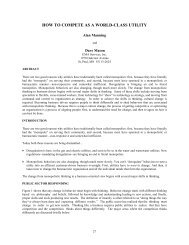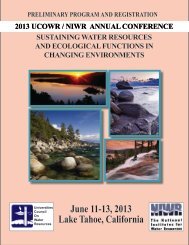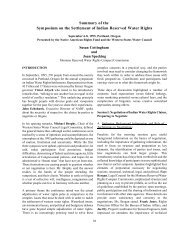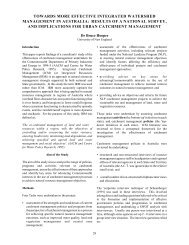46Hussey <strong>and</strong> Doversassessment approach2. river basin management3. a strategy for elimination <strong>of</strong> pollution bydangerous substances4. public information <strong>and</strong> consultation5. the use <strong>of</strong> financial instruments.As is obvious, there are many similaritiesbetween the European Union’s <strong>Water</strong> FrameworkDirective <strong>and</strong> Australia’s National <strong>Water</strong>Initiative, not least in the fact that both entities,unlike the United States, have opted for anoverarching, federal framework for water resourcemanagement. Similarly, the power <strong>and</strong> influence <strong>of</strong>the environmental lobbies in achieving ecologicalobjectives can be seen in each, <strong>and</strong> the strengthenedrole <strong>of</strong> regional, catchment-based institutions isalso evident in both.However, an important difference between thetwo initiatives is the type <strong>of</strong> policy instrumentsadopted. Unlike Australia, the European Unionhas not pursued water trading, instead focusingon the “full cost recovery concept for determiningwater prices” which must, by definition, includeproduction as well as environmental <strong>and</strong> resourcecosts. This instrument clearly reflected theEuropean Union’s requirement that all policiesoperate according to both the polluter pays principle<strong>and</strong> the precautionary principle. The inclusion <strong>of</strong>the full cost-recovery principle was a coup for theenvironment lobby in the European Union, as thepowerful Council <strong>of</strong> Ministers had dem<strong>and</strong>ed it bedropped in the preparatory phase, to be replacedby an “adequate contribution” to the recovery <strong>of</strong>the costs <strong>of</strong> water services <strong>and</strong> further, policies thatprovide “adequate incentives for users to use waterresources efficiently” (Kaika 2003, Kaika <strong>and</strong>Page 2003). It should be noted, however, that theCouncil <strong>of</strong> Ministers did manage to “water down”the full cost recovery for water pricing principlesuch that member states are now only requiredto ensure that the price charged to consumers forfresh water <strong>and</strong> for the treatment <strong>of</strong> wastewaterwill “take into account” the full environmentalcosts (Page 2003).Three other issues are outst<strong>and</strong>ing in the <strong>Water</strong>Framework Directive <strong>and</strong> will pose considerabledifficulties in its implementation: first, it is unclearhow strict the penalties for non-compliance willbe, or how stringently any potential loopholesmay be tightened; second, while environmentalpolicy integration into other sectors <strong>of</strong> theeconomy is a mainstay <strong>of</strong> the European Union’s5th Environmental Action Program, it is unclear inthe document how the <strong>Water</strong> Framework Directivewill impact on the Common Agricultural Policy.Finally, there is speculation that the enormouscosts imposed on the member states to implementthe <strong>Water</strong> Framework Directive will force memberstates to outsource those costs to the private sector,with the result that water might become significantlymore privatized <strong>and</strong> thus “commodified,” despitethe Commission’s claims that “water is not acommercial product” (Kaika <strong>and</strong> Page 2003).Unlike in Australia <strong>and</strong> the European Union,the United States has not developed a nationalframework for the management <strong>of</strong> water resources.<strong>Water</strong> policy <strong>and</strong> law in the United States issignificantly fragmented with the eastern statespredominantly governed by the doctrine <strong>of</strong> riparianrights, while the western states have a systemthat treats water as a kind <strong>of</strong> private property orcommodity, known as prior appropriation. Thereis a third system known as regulated riparianismwhich shares characteristics with the Australianlegal system, whereby the withdrawal <strong>of</strong> waterrequires prior approval <strong>and</strong> the use <strong>of</strong> permits<strong>and</strong> licenses. There are a number <strong>of</strong> deficienciesin United States water law that have not beenaddressed at the national level, which is arguablywhy they are unlikely to be resolved in the nearfuture.First, there are jurisdictional barriers whichhave hindered attempts to successfully legislatefor both human <strong>and</strong> environmental needs in theUnited States to date (Arnold 2005). In particular,jurisdictional fragmentation exists both betweenlevels <strong>of</strong> government <strong>and</strong> within the same level<strong>of</strong> government. For instance, while most pointsourcepollution control is federal in originthrough the Environmental Protection Authority,the responsibility for regulating non-point sourcepollution lies in State h<strong>and</strong>s. Further, wetl<strong>and</strong>regulation is the province primarily <strong>of</strong> the UnitedStates Army Corps <strong>of</strong> Engineers, whereas theenforcement <strong>of</strong> the Endangered Species Act ininl<strong>and</strong> waters belongs to the United States Fish <strong>and</strong>UCOWRJOURNAL OF CONTEMPORARY WATER RESEARCH & EDUCATION
Trajectories in Australian <strong>Water</strong> Policy47Wildlife Service. Moreover, while pollution law<strong>and</strong> the protection <strong>of</strong> biodiversity reside largelyin Federal h<strong>and</strong>s, water quantity, by contrast, isa matter <strong>of</strong> state law – <strong>and</strong> l<strong>and</strong> use managementis generally the domain <strong>of</strong> local government. AsAndreen (2006) warns, successive United Stateslegislators:have spent decades creating… separate legalsystems to govern l<strong>and</strong> use, water use <strong>and</strong> waterpollution, <strong>and</strong> it will take considerable effort todemonstrate to voters, economic interests, <strong>and</strong>decision-makers at all levels <strong>of</strong> governmentprecisely how l<strong>and</strong> use <strong>and</strong> water are inextricablyconnected throughout the whole <strong>of</strong> a watershed.Such jurisdictional fragmentation leads toa second significant problem <strong>of</strong> regulatoryfragmentation between water rights <strong>and</strong> l<strong>and</strong>rights. In the United States, there is a considerableproblem with coordination both vertically withrespect to Federal law, state water law, <strong>and</strong> locall<strong>and</strong> use management, <strong>and</strong> horizontally withrespect to the various agencies <strong>and</strong> political entitiesthat have responsibilities within each subject area.As in Australia, there have been attempts in theUnited States to overcome these jurisdictionalbarriers, including the public trust doctrine <strong>and</strong> theintroduction <strong>of</strong> environmental impact assessments.However, unlike in Australia <strong>and</strong> the EuropeanUnion—where environmental impact assessmentshave been incorporated into all state <strong>and</strong> memberstate legislation—in the United States it has onlybeen enacted into 15 state statutes (Andreen 2006),in addition to the Federal statute. In an effortto overcome this “multi-layered jurisdictionalpuzzle” there have been calls for the development<strong>of</strong> watershed institutions, much like the catchmentbasedinstitutions in the National <strong>Water</strong> Initiative<strong>and</strong> <strong>Water</strong> Framework Directive. However, to datethere has not been a comprehensive Federal pushfor this kind <strong>of</strong> regime change.There are, however, aspects <strong>of</strong> United Stateswater policy that are very similar to those <strong>of</strong> Australia<strong>and</strong> the European Union. The use <strong>of</strong> financialincentives or economic instruments is extensive inthe United States, <strong>and</strong> they are captured in Federal<strong>and</strong> state agri-enviromental schemes such as theconservation programs in the United States FarmBill, <strong>and</strong> vary in substance across the states. <strong>Water</strong>trading has been implemented in some states suchas California where water is scarce but there are nosuggestions that this would become national in extent.Indeed the extensive jurisdictional fragmentationacross levels <strong>of</strong> government would makethat particularly difficult. In the main, however,the United States policy style in the water domaincould be characterized on the one h<strong>and</strong> as administrativerationalism par excellence, <strong>and</strong> on the otherh<strong>and</strong> as economic rationalism owing to the choice<strong>of</strong> policy instruments, if not in terms <strong>of</strong> the role <strong>of</strong>government.In relation to water quality, there is nationallegislation in the form <strong>of</strong> the Clean <strong>Water</strong> Act,although it is focused primarily on point-sourcepollution from industry <strong>and</strong> manufacturing. Fornon-point source pollution, such as that created byagriculture, the United States Congress instructedstates to develop water management plans but thepolicy was “watered down” such that it permittedthe states to use exclusively non-regulatoryavenues such as technical assistance, education,training, <strong>and</strong> demonstration projects to implementthe management plans (Andreen 2006). In UnitedStates agri-environment policy, dual emphasisis placed on both economic incentives, <strong>and</strong>participatory approaches to problem-solving.ConclusionThis paper has established that the apparent“framework” represented by Australia’s National<strong>Water</strong> Initiative—<strong>and</strong> by European Union <strong>and</strong>United States equivalents—contains unresolvedtensions:the dem<strong>and</strong> for a national, property-rights-basedwater management system <strong>and</strong> recognition <strong>of</strong> theneed to hold Australia’s freshwater systems to“environmentally sustainable levels <strong>of</strong> extraction”have resulted in a framework that is weakened byunresolved tensions between the two (Connell etal. 2005).This should not surprise, as framework policies,especially in federal systems <strong>and</strong> in complexpolicy domains such as water, by definition are theproduct <strong>of</strong> political compromise, accommodatingthe aspirations <strong>of</strong> multiple players. The danger liesin forgetting that unresolved differences <strong>and</strong> discoursesremain to be negotiated during implementation <strong>of</strong>the policy, <strong>and</strong> in the construction <strong>and</strong> maintenance<strong>of</strong> water management arrangements consistent withJOURNAL OF CONTEMPORARY WATER RESEARCH & EDUCATIONUCOWR
- Page 3: Journal of ContemporaryWater Resear
- Page 6 and 7: 2Bruce Hooperinstitutional, and tem
- Page 11 and 12: IWRM: Governance, Best Practice, an
- Page 13 and 14: IWRM: Defi nitions and Conceptual M
- Page 15 and 16: IWRM: Defi nitions and Conceptual M
- Page 17 and 18: IWRM: Defi nitions and Conceptual M
- Page 19: IWRM: Defi nitions and Conceptual M
- Page 22 and 23: 18Cardwell. Cole, Cartwright, and M
- Page 24 and 25: 20Mostert26 water boards responsibl
- Page 26 and 27: 22MostertTable 1. Third National Wa
- Page 28 and 29: 24MostertImplementationThe ambitiou
- Page 30 and 31: 26MostertBiswas, A. K. 2004b. Respo
- Page 32 and 33: 28UNIVERSITIES COUNCIL ON WATER RES
- Page 34 and 35: 30Ashton, Turton, and Rouxresource
- Page 36 and 37: 32Ashton, Turton, and Rouxassumptio
- Page 38 and 39: 34Ashton, Turton, and RouxEffective
- Page 40 and 41: 36UNIVERSITIES COUNCIL ON WATER RES
- Page 42 and 43: 38Hussey and Doversin water policy
- Page 44 and 45: 40Hussey and Dovers1994 Council of
- Page 46 and 47: 42Hussey and Doversestablished Thes
- Page 48 and 49: 44Hussey and DoversTable 1. Typolog
- Page 52 and 53: 48Hussey and Doverspolicy goals.Bey
- Page 54 and 55: 50Hussey and DoversFrawley, K. 1994
- Page 56 and 57: 52Mitchelloften took three to four
- Page 58 and 59: 54Mitchelltree preservation plans;
- Page 60 and 61: 56UNIVERSITIES COUNCIL ON WATER RES
- Page 62 and 63: 58Genskow and Borna series of chall
- Page 64 and 65: 60Genskow and BornTable 1. Watershe
- Page 66 and 67: 62Genskow and Bornthe first Dungene
- Page 68 and 69: 64Genskow and BornWashington, DC.Ko
- Page 70 and 71: 66Green and Fernández-BilbaoWithin
- Page 72 and 73: 68Green and Fernández-Bilbaosubjec
- Page 74 and 75: 70Green and Fernández-Bilbaoinflue
- Page 76 and 77: 72Green and Fernández-BilbaoBerbel
- Page 78 and 79: 74UNIVERSITIES COUNCIL ON WATER RES
- Page 80 and 81: 76BallweberEstablish AdvisoryCommit
- Page 82 and 83: 78Ballweberattributes in others (Ch
- Page 84 and 85: 80UNIVERSITIES COUNCIL ON WATER RES
- Page 86 and 87: 82Barreiraand ground water. To this
- Page 88 and 89: 84Barreirawith other states for int
- Page 90 and 91: 86UNIVERSITIES COUNCIL ON WATER RES
- Page 92 and 93: 88Davis and ThrelfallResource Manag
- Page 94 and 95: 90Davis and ThrelfallTable 2. Thirt
- Page 96 and 97: 92Davis and Threlfallby regional an
- Page 98 and 99: 94Davis and Threlfallenforcement, a
- Page 100 and 101:
96Davis and Threlfallhusbandry prac
- Page 102 and 103:
98Davis and ThrelfallNew Zealand: T
- Page 104 and 105:
100UNIVERSITIES COUNCIL ON WATER RE
- Page 106 and 107:
102Lamoree and van SteenbergenIt is
- Page 108 and 109:
104Lamoree and van Steenbergenand n
- Page 110 and 111:
106Lamoree and van Steenbergeninter
- Page 112 and 113:
108BourgetWorks Planner Capability
- Page 114 and 115:
110Bourgetwith over 600 people resp
- Page 116 and 117:
112Bourgetgovernment’s intrusion
- Page 118 and 119:
114Bourget4.management, drought man
- Page 120 and 121:
116McKayFigure 1. The four paradigm
- Page 122 and 123:
118McKay4. Paradigm 4 (which commen
- Page 124 and 125:
120McKaythree main functions:1. ass
- Page 126 and 127:
122McKayState Implementation of the
- Page 128 and 129:
124McKayTable 2. Corporate governan
- Page 130 and 131:
126McKayFigure 4. Qu. 26 - The ESD
- Page 132 and 133:
128McKayFigure 7. Qu.93- This organ
- Page 134 and 135:
130McKayBrundtland Report. 1987. Ou
- Page 136 and 137:
132UCOWR BOARD OF DIRECTORS/COMMITT
- Page 138 and 139:
134BENEFITS OF UCOWR MEMBERSHIPThe
- Page 140 and 141:
136Past Issues of the Journal of Co
- Page 142 and 143:
138Academic Organizations Membershi
- Page 144 and 145:
140Individual Membership Applicatio
- Page 146 and 147:
Universities Council on Water Resou
- Page 148:
Integrated Water Resources Manageme








